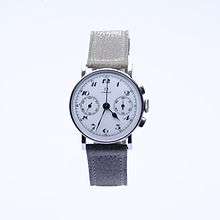Omega 28.9 chronograph
The Omega 28.9 Chronograph was Omega's first small wrist chronograph. Introduced in 1932, production continued until 1943. The watch paved the way for Omega to become one of the most successful manufacturers of Swiss made wrist chronographs.

Introduction
The calibre 28.9 was introduced as Omega SA watches' first production wrist chronograph in 1932 featuring 17 rubies, Bregeut balance and continuous minute hand.[1] Lemania produced the watch for the most part under license when it joined SSIH for Omega and it was made in very small numbers for a little over ten years. Omega SA produced three main types of the calibre 28.9 movement:
T1, which utilized a single pusher T2, which utilized two pushers T3, which again utilized twin pushers
The movement was manual wind.
Early development
The movement was developed following the success of the Omega calibre 18’’’ wrist watch, which was a development of the Calibre 19”’ pocket chronographs.
The most famous owner of an Omega calibre 18” wrist chronograph was T.E. Lawrence otherwise known as Laurence of Arabia.[2]
The calibre 28.9 was designed primarily as small wrist chronograph to be worn for sports or by professionals and was marketed primarily at sportsmen and pilots. The watch was introduced in production form in 1932 and was produced in very small numbers up until circa 1943.[3]
This watch marked the introduction of the Omega wrist chronograph in production form, which would later evolve through the calibre 33.3 to the calibre 321, fitted to the famous Omega ‘moon watch’ used even today by NASA.
Production watches
Numerous manufacturers utilized the calibre 28.9 movement, including Tissot and Lemania under calibre 13CH. The movement was most successfully adopted by Omega who under calibre 28.9 manufactured three variants, T1, T2 and T3 in numerous configurations in both stainless steel and precious metals, most notably 18ct solid gold.
Stainless steel examples of this watch were used by the commanders and pilots of the Italo Balbo air force who used them on trans-Atlantic crossings. Other famous owners included Amelia Earhart who was wearing a calibre 28.9 T1 enamel dial when she disappeared during a transpacific crossing.[4]
The watch was produced with a number of variations of chronograph dial, some in enamel and some in painted brass, including some very rare prototypes such as the inserted drivers chronograph dating from circa 1937.[5]

The watches were small by modern standards and reliability issues resulted in Omega introducing the calibre 33.3 in 1933 at which point the 28.9 was slowly phased out of the range and had been discontinued by 1943.
Further developments
The Omega 28.9 chronograph paved the way for the introduction of the calibre 33.3 a more accurate and larger wrist chronograph, this in turn evolved into the calibre 27 CHRO and later the calibre 321 and then 861. The calibre 321 and 861 are undoubtedly Omega's most famous chronograph watches and have been incorporated into a range of wrist chronographs including being the only watch certified for EVA use by NASA and still issued to this day to their astronauts.[6]
Summary
Despite the significance of the calibre 28.9 wrist chronograph it was produced in relatively small numbers over the eleven-year period. Technological developments and the introduction of the larger calibre 33.3 movement, which was larger and more reliable, resulted in the demise of the calibre 28.9. Nonetheless it marked the first production wrist chronograph manufactured by Omega and paved the way for the company to become one of the most successful manufacturers of chronographs watches in the world.
Calibre 28.9 chronographs are now extremely rare and as such highly sought after by collectors and enthusiasts.
External links
References
- ↑ Richon, Marco (2007). A Journey Through Time. Omega Ltd. P.530. ISBN 9782970056225
- ↑ Richon, Marco (2007). A Journey Through Time. Omega Ltd. P.526. ISBN 9782970056225
- ↑ Richon, Marco (2007). A Journey Through Time. Omega Ltd. P.531. ISBN 9782970056225
- ↑ Richon, Marco (2007). A Journey Through Time. Omega Ltd. P.508. ISBN 9782970056225
- ↑ Richon, Marco (2007). A Journey Through Time. Omega Ltd. P.530. ISBN 9782970056225
- ↑ Richon, Marco (2007). A Journey Through Time. Omega Ltd. P.533. ISBN 9782970056225